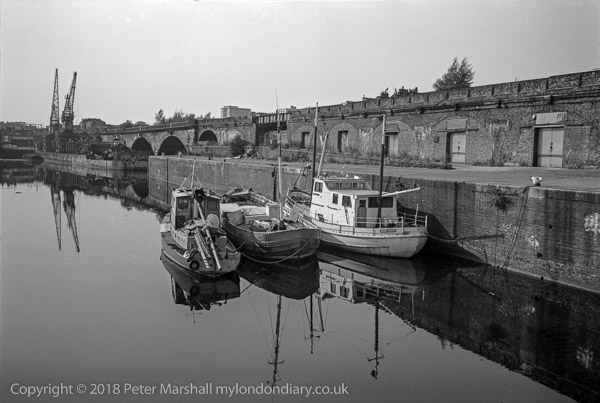London 1981
Peter MARSHALL

Limehouse Dock, Limehouse, 1981
29j-43: dock, canal, railway, boats, Tower Hamlets
You can click on the image to go to the next picture
The Regent's Canal Dock, also known as Limehouse Dock and now more usually as Limehouse Basin, was built in 1820 and was made large enough to allow the sea-going vessels then in use to enter and transfer goods there to and from canal boats. In its early years it was an important centre for the coal trade with some coal being taken out by waggons on the Commercial Rd, some up the canal and some in lighters to wharves and works on the River Thames. The coal trade was growing fast, particularly for the new gas works, but also with the growth of the city.
To meet competition from the railways and the new dock at Poplar, Limehouse Dock was enlarged to the east and wooden jetties built, replaced by a concrete one in the 1920s, and I think this picture was taken from one of these still present in 1981, but demolished during work for the Limehouse Link.
The dock was also one of the first to use hydraulic cranes, and the second accumulator tower built to provide high pressure water, just out of picture to the right is still present (and listed.)
The creation of the London Docklands Development Corporation (LDDC) in 1981, around the time I made this picture, has led to considerable development around the dock, beginning in 1983, and the railway viaduct originally built for the London and Blackwall Railway now carries the frequent trains of the Docklands light railway which allows glimpses of the dock in the gaps between the new flats.
The development on this quay was held up for some years by the building of the tunnel of the Limehouse Link from 1989-93 which runs under the quay shown here. Although the basin may be still more or less the same size, the surrounding buildings make it seem smaller.
The mouth of the Regent's canal is towards the left of the picture. It leaves the basin through a lock underneath the railway and goes under the Commercial Road shortly beyond this.
The scrapyard beyond the canal was begun by George Cohen at 600 Commercial Road in 1834, and later expanded onto an area of the basin that was filled in; it appears still to be working in 1981. Later it became George Cohen, Sons and Co, and over the years became eventually it and the many subsidiaries became 'The 600 Group' taking its name from the street number. I think most of its many companies had ceased trading or been taken over by the early years of this century.
To meet competition from the railways and the new dock at Poplar, Limehouse Dock was enlarged to the east and wooden jetties built, replaced by a concrete one in the 1920s, and I think this picture was taken from one of these still present in 1981, but demolished during work for the Limehouse Link.
The dock was also one of the first to use hydraulic cranes, and the second accumulator tower built to provide high pressure water, just out of picture to the right is still present (and listed.)
The creation of the London Docklands Development Corporation (LDDC) in 1981, around the time I made this picture, has led to considerable development around the dock, beginning in 1983, and the railway viaduct originally built for the London and Blackwall Railway now carries the frequent trains of the Docklands light railway which allows glimpses of the dock in the gaps between the new flats.
The development on this quay was held up for some years by the building of the tunnel of the Limehouse Link from 1989-93 which runs under the quay shown here. Although the basin may be still more or less the same size, the surrounding buildings make it seem smaller.
The mouth of the Regent's canal is towards the left of the picture. It leaves the basin through a lock underneath the railway and goes under the Commercial Road shortly beyond this.
The scrapyard beyond the canal was begun by George Cohen at 600 Commercial Road in 1834, and later expanded onto an area of the basin that was filled in; it appears still to be working in 1981. Later it became George Cohen, Sons and Co, and over the years became eventually it and the many subsidiaries became 'The 600 Group' taking its name from the street number. I think most of its many companies had ceased trading or been taken over by the early years of this century.